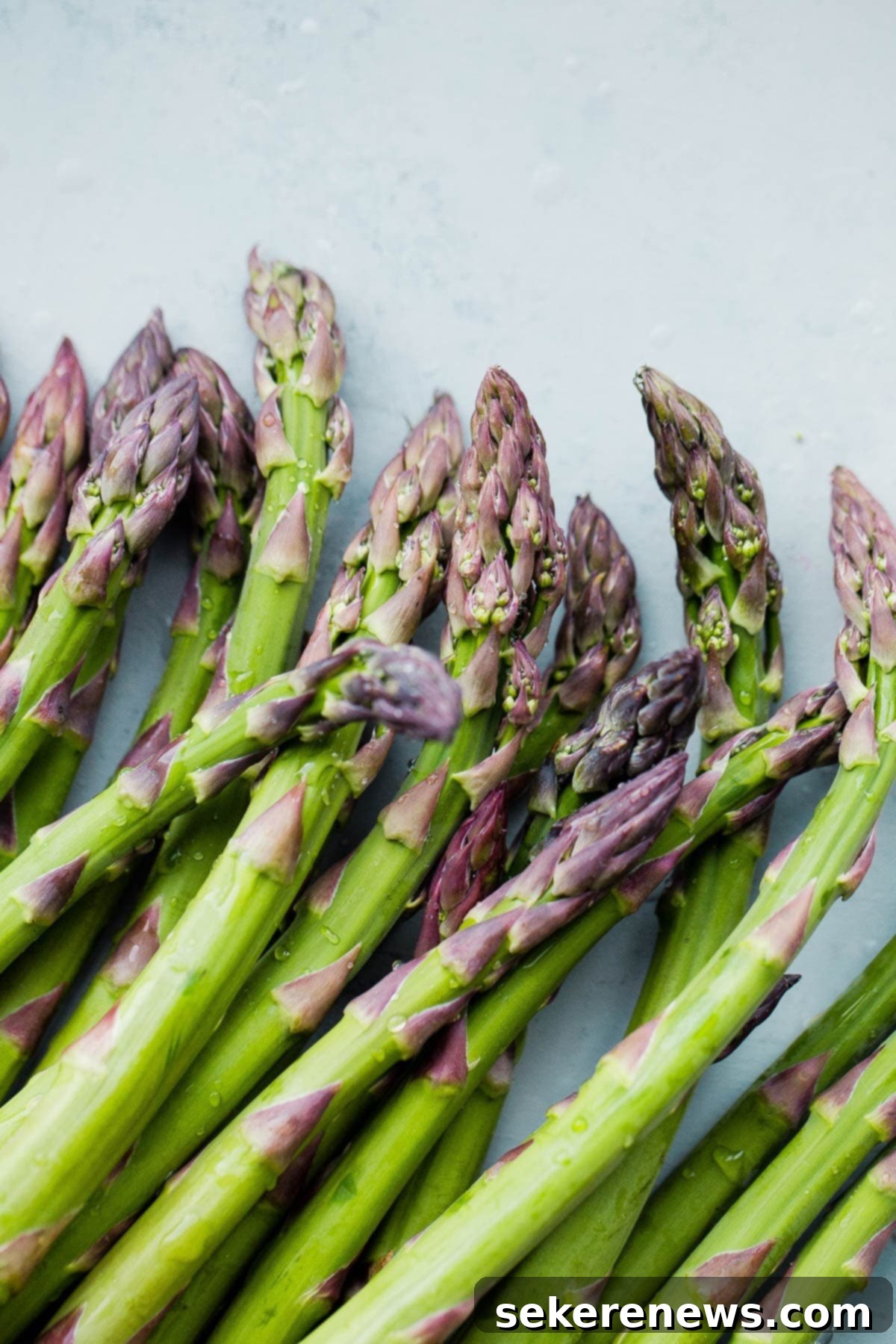Mastering Asparagus: Your Complete Guide to Picking, Storing, and Cooking This Spring Delicacy
Shopping Tips |
How to Store |
Varieties |
Cooking Tips |
Health Benefits |
Recipes
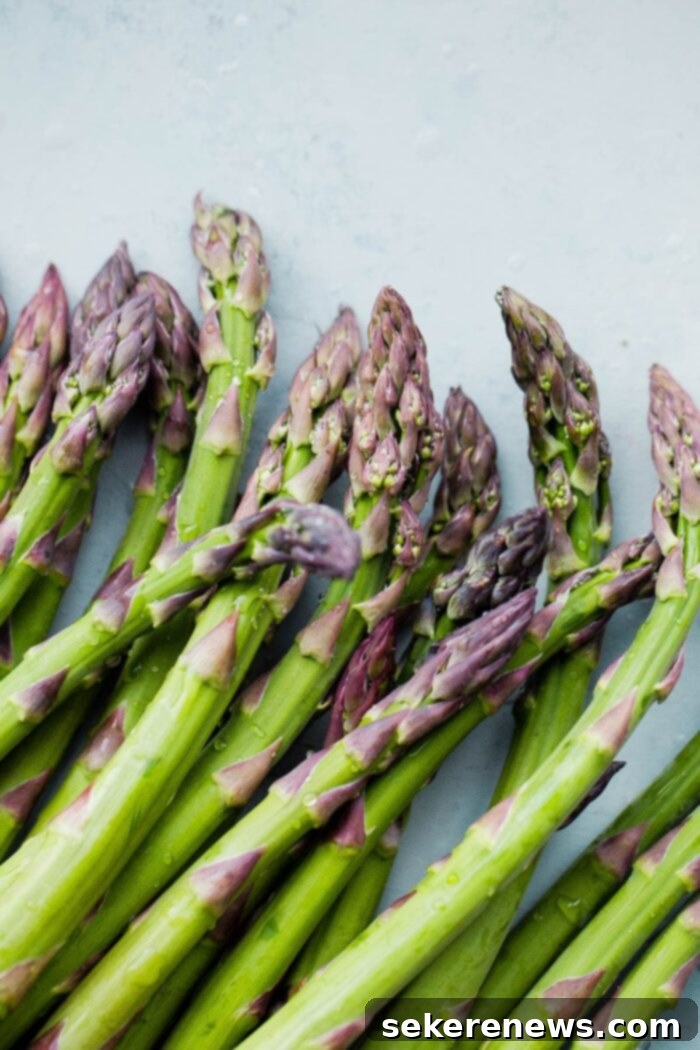
Asparagus season is a truly special time for food lovers! As spring blossoms, this vibrant and versatile vegetable makes its much-anticipated appearance, signaling freshness and culinary delight. There’s nothing quite like the crisp tenderness and distinct flavor of freshly picked asparagus, especially when sourced locally. This comprehensive guide will delve deep into everything you need to know about this beloved spring vegetable: from expert shopping tips and understanding its various types to optimal storage methods, versatile cooking techniques, its impressive health benefits, and inspiring recipe ideas. Get ready to embrace the season and make the most of every delicious spear.
Let’s uncover the secrets to enjoying asparagus at its very best!
How to Pick the Freshest Asparagus: Expert Shopping Tips
Asparagus season typically graces us from March to early June, making this the prime window to find the most exceptional, locally or regionally sourced spears. This short but sweet season is when asparagus is at its peak in terms of flavor and nutritional value. Capitalize on this period for the freshest produce, as asparagus quality significantly impacts its taste and texture.
Much like many other delicate vegetables, asparagus rapidly loses moisture, flavor compounds, and beneficial antioxidants once it’s harvested. Its natural sugar content, which contributes significantly to its sweet and earthy taste, is highest when it’s just picked. Therefore, for the ultimate culinary experience, it’s best to enjoy asparagus in season, prioritize local sourcing whenever possible, and aim to prepare it the same day, or at most, the day after purchase. This ensures you’re getting the best possible flavor and nutrient density.
When selecting your bunches, look for several key indicators of freshness: choose firm, straight stalks that show no signs of limpness or bending, which can indicate dehydration and age. The spears should be tightly closed, with compact tips; open, flowering, or mushy tips suggest the asparagus is past its prime and may be tougher or less flavorful. Examine the cut ends – they should appear smooth, moist, and vibrant in color, not woody, dry, shriveled, or white. Avoid any spears that look bruised, withered, or excessively brittle, as these are clear signs of poor quality. A helpful tip at the market is to check bunches stored in shallow water baths; these often retain moisture better and are likely to be fresher than those left dry.
It’s important to remember that asparagus stalk thickness is not an indication of quality or maturity. Instead, it’s typically related to the age and specific variety of the plant. Both thick and thin spears can be equally delicious when fresh. However, their size does influence cooking times and methods; thinner spears cook faster and are often more tender, while thicker ones can withstand longer cooking methods like grilling or roasting, developing a richer flavor. Consider what you plan to cook when choosing your preferred thickness.
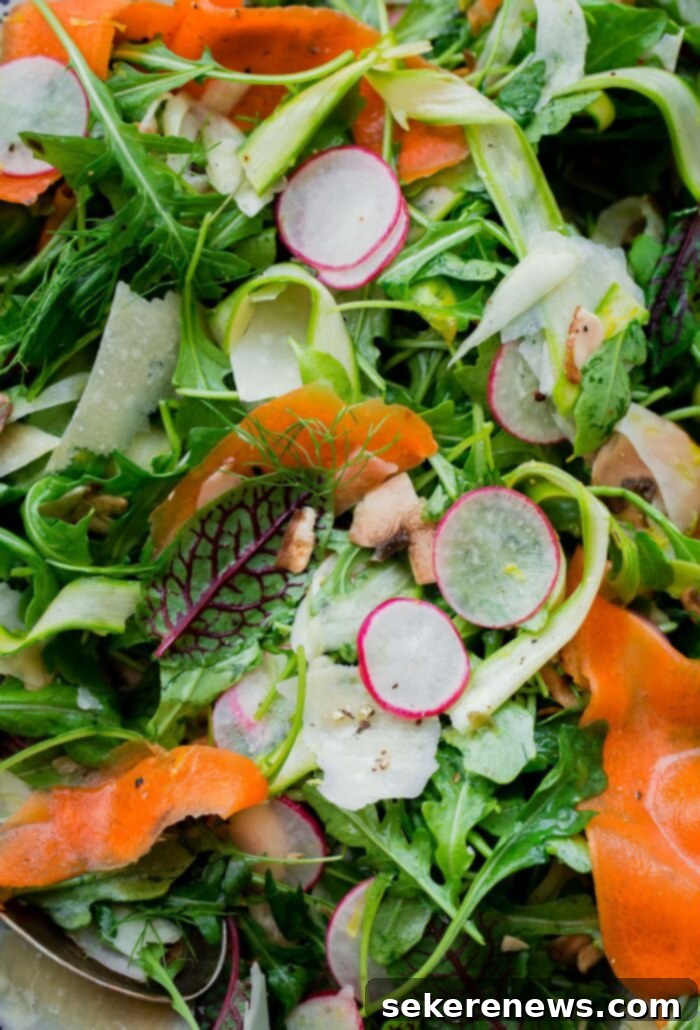

How to Store Asparagus for Maximum Freshness and Shelf Life
Proper storage is crucial for extending the life and maintaining the quality of your fresh asparagus. Once harvested, asparagus begins to lose its natural sugars and nutrients quite rapidly, leading to tougher, less flavorful spears. The goal of effective storage is to keep the asparagus hydrated and cool, slowing down this natural deterioration process. By following these simple methods, you can significantly improve its shelf life and enjoy fresher, more delicious asparagus for longer.
Here are two highly effective methods for storing asparagus:
- The Damp Linen Method: First, remove any rubber bands that might be constricting the stalks, as these can cause bruising and moisture loss. Take a clean, lightly damp kitchen towel or paper towel and gently wrap it around the cut ends of the asparagus stalks. This provides a moist barrier, preventing the ends from drying out. Place the entire bundle into a perforated plastic bag (like the ones used for produce at the grocery store) or a loosely sealed Ziplock bag. The slight ventilation prevents excess moisture buildup, which can lead to mold. Store this in the crisper drawer of your refrigerator, where the temperature and humidity are typically optimized for fresh vegetables.
- The Water Jar Method (Flower Arrangement Style): This method is visually appealing and highly effective for keeping spears crisp. Begin by trimming about half an inch off the bottom of the asparagus stalks. Place the stalks, spears facing upwards, into a wide-mouthed jar or a tall glass. Fill the jar with approximately 1 inch of fresh water, ensuring that the freshly cut ends are fully submerged. This allows the asparagus to continuously draw water, much like cut flowers in a vase, rehydrating the stalks. You can then loosely cover the top of the spears with a plastic bag (or even the original produce bag) to maintain humidity and further prevent them from drying out. Store this arrangement in your refrigerator. Remember to change the water every day or two to keep it clean and fresh.
Regardless of the method you choose, aim to use your asparagus within 3 to 5 days of purchasing for the best flavor and texture. It’s important to avoid rinsing or washing the stalks until just before you’re ready to use them, as excess moisture on the spears themselves can encourage spoilage. When it’s time to cook, gently bend each spear; it will naturally snap at the point where the tough, woody end meets the tender, edible part. This is an intuitive way to ensure you’re only keeping the most delicious sections. Alternatively, you can use a knife to trim the ends. If you find the lower ends still a bit fibrous after trimming, a vegetable peeler can be used to lightly peel the tough outer skin off the bottom few inches of the stalk, revealing tender flesh underneath.
For longer-term storage, asparagus can also be frozen. To do this, blanch the trimmed asparagus in boiling water for 2-4 minutes (depending on thickness), then immediately plunge it into an ice bath to stop the cooking process. Drain thoroughly, pat dry, and then freeze in a single layer on a baking sheet before transferring to a freezer-safe bag. Frozen asparagus is best used in cooked dishes like soups or casseroles.
Remember, wrinkled, dry, or excessively tough stalks are clear indicators that the asparagus has been off the plant for a while, leading to increased trimming waste and a diminished culinary experience. By prioritizing locally grown and in-season asparagus, you not only get unparalleled quality and freshness but also support sustainable agricultural practices and farmers.
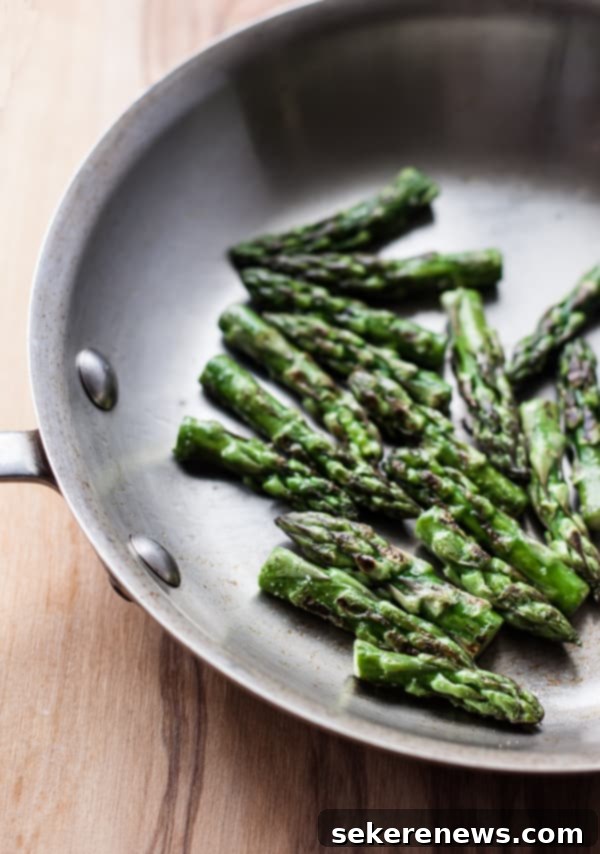
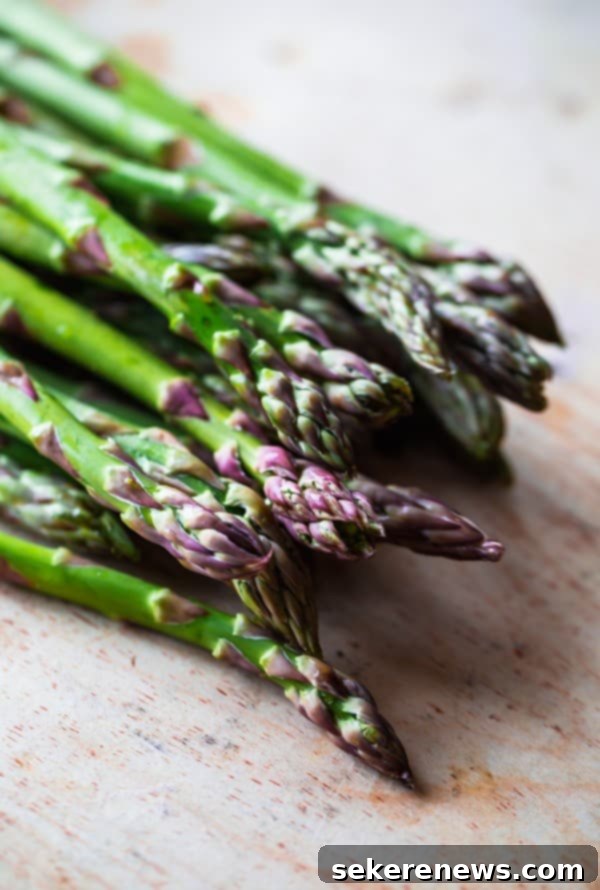
Exploring the Diverse Types of Asparagus Varieties
While often hard to find outside of specialized markets or local farmer’s markets, the world of asparagus offers a fascinating array of varieties that differ in color, flavor, and culinary application. Beyond the familiar green spear, exploring these types can add exciting dimensions to your spring dishes and broaden your culinary horizons.
Green Asparagus: This is by far the most commonly available and recognized type of asparagus. Its robust, slightly earthy flavor and tender-crisp texture make it incredibly versatile for almost any cooking method, from roasting to steaming to sautéing. Within green asparagus, there are numerous cultivars, some yielding thicker stalks, others thinner. If you ever come across green asparagus with distinct dark purple spears (as seen in one of the photos above), consider yourself lucky and grab them! These are often local varieties, celebrated for their exceptionally rich flavor, sweetness, and tenderness, indicative of optimal growing conditions.
Purple Asparagus: A true culinary gem, purple asparagus offers a sweeter, fruitier, and notably milder flavor profile compared to its green counterpart, with less of the characteristic bitterness. Its striking color comes from anthocyanins, powerful antioxidants, and this variety boasts up to three times the antioxidants of most green varieties. However, these beautiful anthocyanins are sensitive to heat and water; when cooked extensively or boiled, purple asparagus tends to lose its vibrant hue, turning a more muted green. To preserve its stunning color and delicate flavor, opt for raw preparations like shaved salads, quick searing on the grill, or a very brief sauté. It’s truly a showstopper on a plate.
White Asparagus: This elegant variety is not a separate species but rather green asparagus grown under specific conditions to prevent it from developing chlorophyll. Farmers achieve this by covering the emerging spears with mounds of soil (a process called “etiolation”) or picking them just as they peek through the ground. Because they are not exposed to sunlight, they remain pale. White asparagus has a distinctly mild, delicate, and slightly nutty flavor, often described as less bitter or more subtle than green asparagus. While lower in certain nutrients like Vitamin A (due to the lack of chlorophyll), it is highly prized in European, especially German and French, cuisine, where it’s often served simply with hollandaise sauce, butter, or in creamy preparations. Its tender texture makes it ideal for blanching, steaming, or simmering, showcasing its refined taste.
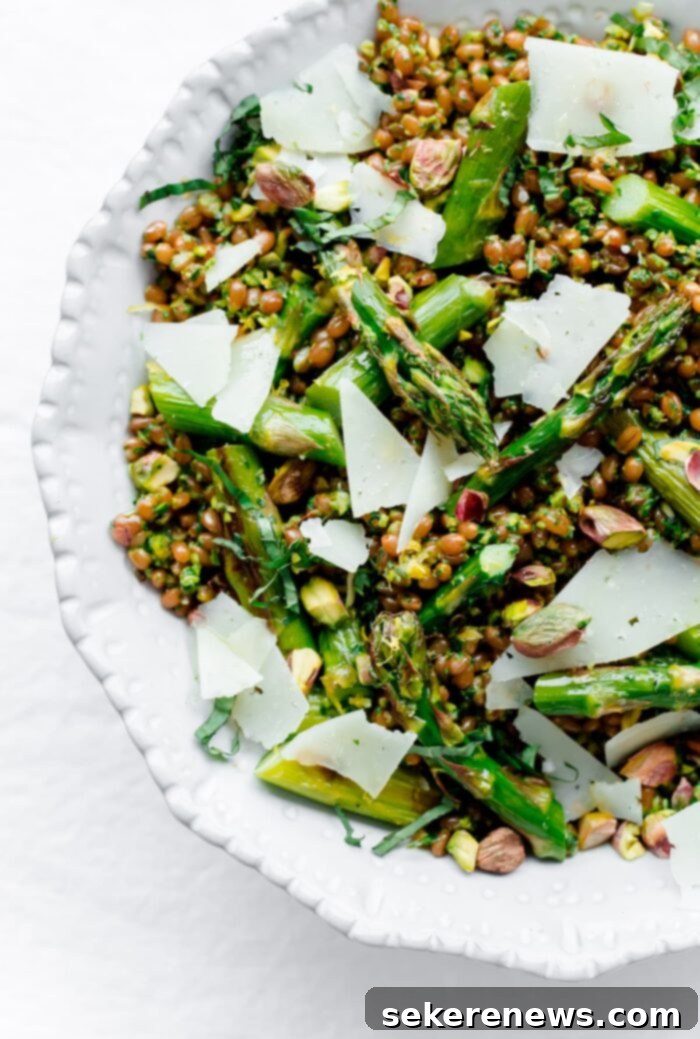

Mastering Asparagus: Diverse Cooking Methods for Every Preference
Asparagus is incredibly versatile, lending itself to a myriad of cooking techniques that can highlight its delicate flavor and tender texture. While steamed asparagus is known to retain higher levels of certain antioxidants compared to raw, my absolute favorite ways to prepare this spring delight often involve dry heat, which brings out its natural sweetness and a hint of nutty flavor through caramelization.
Roasting and Grilling: The Flavor Enhancers
For a truly delicious result, toss trimmed asparagus stalks with a good quality olive oil, a generous pinch of sea salt, and freshly ground black pepper. Then, either spread them in a single layer on a baking sheet and roast in a hot oven (around 425°-450°F / 220°-230°C) for 8-15 minutes, or grill them over medium-high heat until they are tender-crisp and slightly charred. This method is particularly well-suited for thicker asparagus spears, as the intense heat helps to tenderize them while adding a lovely smoky or nutty depth of flavor. Roasting brings out their inherent sweetness beautifully, making it a crowd-pleaser.
Sautéing: Quick and Tender
If you have thinner, more delicate asparagus stalks, sautéing is an excellent choice for a quick preparation that locks in flavor and maintains a crisp texture. Chop or slice the spears on a bias into 1 to 2-inch pieces for even cooking. Heat a little olive oil or butter in a wok or skillet over medium-high heat. Add the asparagus and sauté for just a few minutes (typically 3-5 minutes) until they are bright green and fork-tender, yet still retain a slight bite. This method is perfect for incorporating asparagus into stir-fries, omelets, pasta dishes, or as a simple side dish that comes together in minutes.
Steaming and Blanching: Preserving Color and Nutrients
Steaming or blanching asparagus is ideal when you want to preserve its vibrant green color and delicate, fresh texture, especially for salads or as a gentle side. For steaming, place the trimmed asparagus in a steamer basket over boiling water for 3-5 minutes, or until tender-crisp. For blanching, quickly immerse the asparagus in boiling salted water for 1-2 minutes, then immediately transfer it to an ice bath to stop the cooking process and set that beautiful green hue. This technique, wonderfully demonstrated in recipes like Asparagus and Goat Cheese Quiche, is perfect for preparing asparagus for cold salads, elegant platters, or for dishes where it will be further cooked later, ensuring it doesn’t become overdone.
Raw Preparations and Unique Uses
Don’t overlook the potential of raw asparagus! Thicker asparagus stalks can be beautifully shaved into delicate ribbons using a vegetable peeler. These ribbons add a wonderful crunch, fresh flavor, and a visually appealing element to salads, such as this refreshing Shaved Vegetable Salad. Raw preparations are especially fantastic for purple asparagus, as it helps preserve its stunning color and sweeter taste. Asparagus is also wonderful in creamy pureed dishes like Asparagus Soup, adding a subtle, earthy base and a lovely green hue.
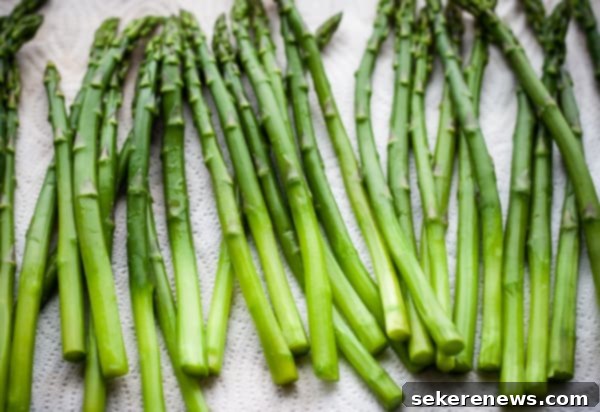
Quick Cook Tip for Pasta: If you’re preparing a spring pasta dish, here’s a time-saving trick for adding fresh vegetables with minimal fuss. A minute or two before your pasta is finished cooking and is still in its boiling water, drop chopped asparagus (and other quick-cooking vegetables like frozen peas or spinach) directly into the salted pasta water. They will cook perfectly alongside the pasta, becoming tender-crisp. This allows you to drain everything together and instantly incorporate healthy, vibrant vegetables into your meal, boosting both flavor and nutrition in one simple step.

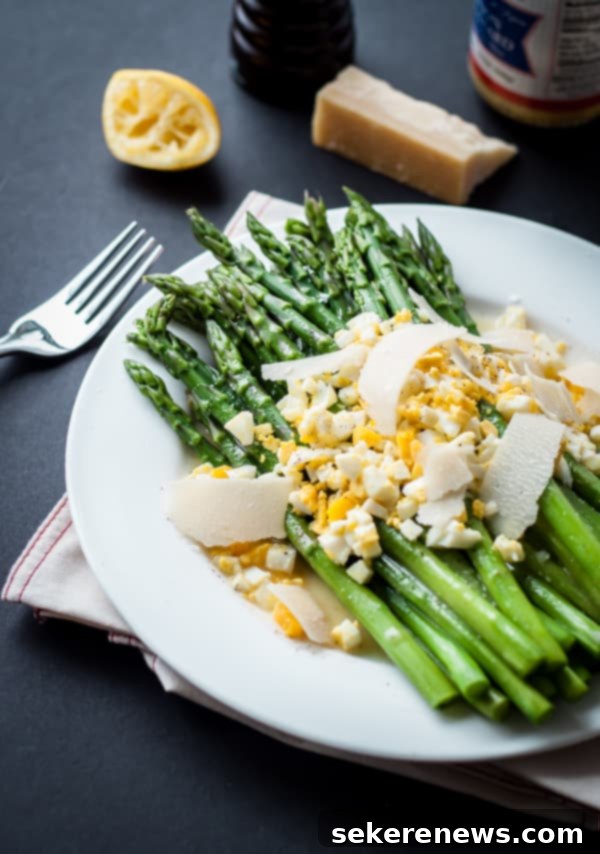
The Amazing Health Benefits of Asparagus
Beyond its delicious taste and versatility in the kitchen, asparagus is a nutritional powerhouse packed with numerous health benefits, making it an excellent and highly recommended addition to a balanced spring diet. Incorporating this vibrant vegetable into your meals can contribute significantly to your overall well-being.
Asparagus is notably rich in a variety of essential vitamins and minerals:
- Vitamins: It’s an excellent source of Vitamin K, a fat-soluble vitamin crucial for proper blood clotting and maintaining strong bone health. It also provides a good amount of Vitamin A (in the form of beta-carotene), which is vital for healthy vision, robust immune function, and skin health. Additionally, it offers Vitamin C, a powerful antioxidant that further supports skin integrity and boosts immunity. Furthermore, asparagus stands out as one of the best vegetable sources of Folate (Vitamin B9), which is essential for cell growth, DNA formation, and crucial during periods of rapid growth like pregnancy.
- Minerals: Asparagus contains important minerals such as potassium, which plays a key role in regulating blood pressure and fluid balance, and iron, essential for oxygen transport in the blood and preventing fatigue. It also provides smaller but significant amounts of zinc, selenium, and manganese, all contributing to various bodily functions.
In addition to these vital micronutrients, asparagus is a great source of:
- Dietary Fiber: Both soluble and insoluble fibers are present in asparagus. Dietary fiber aids in healthy digestion, promotes a thriving gut microbiome, and helps maintain stable blood sugar levels. A high-fiber diet can also contribute to a feeling of fullness, assisting with healthy weight management.
- Antioxidants: Asparagus is loaded with a diverse range of antioxidants, including flavonoids and polyphenols. These powerful compounds help protect your cells from damage caused by harmful free radicals, thereby reducing oxidative stress and potentially lowering the risk of chronic diseases such as heart disease and certain cancers. As noted earlier, purple asparagus is particularly rich in anthocyanins, a specific type of antioxidant responsible for its vibrant color.
- Diuretic Properties: Asparagus has natural diuretic properties, which can help promote urine production and reduce excess water and salt from the body. This can be beneficial for kidney health and can help alleviate bloating.
With its low calorie count, high water content, and impressive nutrient density, asparagus is truly a champion vegetable that offers both culinary delight and significant health advantages. Enjoying it regularly during its peak season is a fantastic and delicious way to boost your nutritional intake and support a healthy lifestyle.
Delicious Flavor Pairings and Asparagus Recipes
Asparagus, with its relatively delicate yet distinct flavor, harmonizes beautifully with a variety of ingredients, allowing for endless culinary creativity. Understanding these natural pairings can elevate your asparagus dishes from good to truly extraordinary. Its slightly sweet and earthy notes are particularly complemented by acidic, savory, and creamy elements, making it incredibly versatile in the kitchen.
Some classic and highly successful flavor pairings for asparagus include:
- Eggs: The creamy richness of eggs, whether poached, fried, scrambled, or incorporated into a frittata or omelet, creates a perfect balance with the fresh crispness of asparagus. This classic pairing is a brunch favorite.
- Cheese: Hard, salty cheeses like Parmigiano-Reggiano or Pecorino Romano add an irresistible umami depth and texture. Creamy, tangy goat cheese also pairs exceptionally well, as demonstrated in many spring tarts and quiches, providing a delightful counterpoint to asparagus’s subtle flavor.
- Lemon and Other Citrus: A squeeze of fresh lemon juice, a sprinkle of zest, or even a splash of orange juice can brighten and lift the flavor of asparagus, cutting through any slight bitterness and adding a refreshing finish.
- Garlic: The pungent warmth of garlic is a natural and indispensable companion, enhancing the savory qualities of asparagus without overpowering its subtle taste. Garlic and asparagus sautéed together is a simple, perfect side dish.
- Tarragon: This aromatic herb, with its distinctive licorice-like or aniseed-like aroma and subtle peppery notes, adds an elegant touch that complements asparagus beautifully, especially in classic French preparations or light sauces.
- Mushrooms: Earthy mushrooms provide another layer of umami and a satisfying texture, creating a delightful synergy with asparagus in sautés, risottos, or pasta dishes.
- Balsamic Vinegar: A drizzle of good quality balsamic vinegar, especially aged varieties, introduces a sweet-tart complexity that beautifully contrasts with and enhances the natural sweetness of roasted or grilled asparagus.
These pairings form the foundation for many beloved asparagus dishes. Whether you’re aiming for a light side dish, a hearty main, or a flavorful appetizer, asparagus is an ingredient that truly shines and invites culinary experimentation.
Here are a few of my favorite asparagus recipes to inspire your spring cooking and help you make the most of this wonderful vegetable:
- Roasted Asparagus Wheat Berry Salad with Arugula Pistachio Pesto
- Asparagus Potato Soup with Chive Cream
- Asparagus Egg Puff Pastry Tart
- Spring Asparagus and Goat Cheese Quiche
- Classic Asparagus Mimosa Salad
Embrace the asparagus season and enjoy incorporating this versatile, delicious, and highly nutritious vegetable into all your spring meals. From simple roasted spears to elegant quiches and flavorful salads, there are countless ways to savor its unique taste and benefit from its healthful properties. We hope this guide helps you master the art of asparagus from market to table. Happy cooking!
Resources:
- Eating on the Wild Side: The Missing Link to Optimum Health by Jo Robinson
- The Flavor Bible + The Vegetarian Flavor Bible by Karen Page and Andrew Domenburg
- On Food and Cooking: The Science and Lore of the Kitchen by Harold McGee
- The Chef’s Garden by Farmer Lee Jones and Kristin Donnelly
